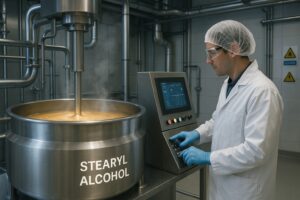Furfuryl alcohol is a colorless, slightly oily liquid with a characteristic sweet-caramel smell, produced from biomass – mainly corn husks and grain bran. It is its role as a raw material from nature that combines the principles of the chemical industry with ecology. Thanks to its unique structure (furan + hydroxyl group), this alcohol is a powerful structural material in the industry of furfural and polyfurfural resins.
The technical product is available on Vichemic’s Furfuryl Alcohol page, where ≥99% purity solutions and “technical” versions for industrial applications are offered.
Natural origin and production
Furfuryl alcohol is classified as a biorefined feed stock – produced by hydrolyzing hemicellulose to furfural and then reducing it to furfuryl. The resulting raw material is an example of circular chemistry technology: based on local resources and reducing CO₂ emissions.
Its properties are:
- Content: ≥99 % – pure furan industrial alcohol
- Boiling point: 161-164 °C
- Low evaporation: stable at 20°C
- Sensitivity: subject to photodegradation and requires stable, dark packaging
Most important applications
1. source of furfuryl resins
Furfuryl alcohol is the primary monomer in the production of furfural resins, which are used to impregnate wood, metal castings and ceramics, and for silicone molds. The absence of styrene makes them more environmentally friendly and less toxic.
2. industry cutting and casting molds
Molding pastes for casting iron, aluminum and copper are created on the basis of furfuryl. In light of the increase in performance and resistance to high temperatures, these molds are chosen by metallurgists and industrial foundrymen. It is this raw material that Vichemic offers.
3. biopolymers and composite materials
Research into furfuryl alcohol polymers is leading to modern materials for use in insulation, 3D printing, filters or biodegradable packaging. They open up a new perspective for the raw material in terms of sustainability and ecology.
4. fuel industry and waste
Furfuryl can be used in refining as a hydrocracking agent and added to jet fuels, increasing their efficiency. This is a promising technology for a closed-loop economy.
Safety and storage
- GHS class flammability – stored in cool, ventilated areas
- Photosensitivity – use dark PET/HDPE packaging
- When working – use masks with filters, gloves and safety goggles
- A toxin for microorganisms – a good disinfectant and fungistatic agent
Innovation and ecotrend
Furfuryl alcohol is gaining popularity due to its biorefinery origin and growing interest in the concrete and molding industry. Its eco-friendly performance is already being tested as an additive to polymer plastics to aid biodegradation and thermoplasticity.
Trivia
- Furan was the first aromatic compound obtained synthetically by Liebig in 1826.
- Furfuryl resin molds with cast iron have gained a patent register as “eco-iron” – thanks to its low slumps.
- In scientific trials, furfuryl alcohol served as a waterproofing agent for dirt roads – an icon of agricultural waste circulation studies.
Summary
Furfuryl alcohol is a compound with a unique combination of natural history and modern industrial applications. From ceramics and resins to fuels and biopolymers, its presence in Vichemic ‘s portfolio makes it a strategic choice for companies that want to combine technology with sustainability.
Zobacz także

Stearic alcohol – a luxury emollient, stabilizer and secret ingredient of many industries
Stearic alcohol, also known as 1-octadecanol, is a long-chain saturated fatty alcohol with the formula C₁₈H₃₈O. Despite its technical-sounding name, it is one of the mildest and most desirable ingredients used in cosmetics, pharmaceuticals and the engineering industry. Its key properties – a soft, waxy texture, excellent emollient properties and a neutral fragrance – make […]
Read more 
Acrylamide – A key monomer for the water, wastewater and biotechnology industries
Acrylamide is a reactive, colorless monomer used on a massive scale in the synthesis of polyacrylamides and other engineering polymers. Its presence in a wide range of sectors – from water treatment to mining to biological laboratories – makes it an extremely important ingredient in modern industrial chemistry. Despite the need for special care in […]
Read more 
Isopropyl alcohol – an irreplaceable industrial and laboratory solvent
Isopropyl alcohol (IPA, 2-propanol) is a colorless liquid with a slightly sweetish, pungent odor. For decades it has been considered one of the most versatile and fastest evaporating solvents. It is used both in the cleaning of precision electronic equipment and in the production of cosmetics, medicines or laboratory materials. The product available from Vichemic […]
Read more 

